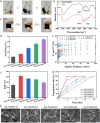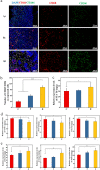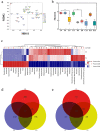A physicochemical double-cross-linked gelatin hydrogel with enhanced antibacterial and anti-inflammatory capabilities for improving wound healing
- PMID: 36153602
- PMCID: PMC9509571
- DOI: 10.1186/s12951-022-01634-z
A physicochemical double-cross-linked gelatin hydrogel with enhanced antibacterial and anti-inflammatory capabilities for improving wound healing
Erratum in
-
Correction: A physicochemical double-cross-linked gelatin hydrogel with enhanced antibacterial and anti-inflammatory capabilities for improving wound healing.J Nanobiotechnology. 2023 Aug 8;21(1):262. doi: 10.1186/s12951-023-02029-4. J Nanobiotechnology. 2023. PMID: 37553673 Free PMC article. No abstract available.
Abstract
Background: Skin tissue is vital in protecting the body from injuries and bacterial infections. Wound infection caused by bacterial colonization is one of the main factors hindering wound healing. Wound infection caused by colonization of a large number of bacteria can cause the wound to enter a continuous stage of inflammation, which delays wound healing. Hydrogel wound dressing is composed of natural and synthetic polymers, which can absorb tissue fluid, improve the local microenvironment of wound, and promote wound healing. However, in the preparation process of hydrogel, the complex preparation process and poor biological efficacy limit the application of hydrogel wound dressing in complex wound environment. Therefore, it is particularly important to develop and prepare hydrogel dressings with simple technology, good physical properties and biological effects by using natural polymers.
Results: In this study, a gelatin-based (Tsg-THA&Fe) hydrogel was created by mixing trivalent iron (Fe3+) and 2,3,4-trihydroxybenzaldehyde (THA) to form a complex (THA&Fe), followed by a simple Schiff base reaction with tilapia skin gelatin (Tsg). The gel time and rheological properties of the hydrogels were adjusted by controlling the number of complexes. The dynamic cross-linking of the coordination bonds (o-phthalmictriol-Fe3+) and Schiff base bonds allows hydrogels to have good self-healing and injectable properties. In vitro experiments confirmed that the hydrogel had good biocompatibility and biodegradability as well as adhesion, hemostasis, and antibacterial properties. The feasibility of Tsg-THA&Fe hydrogel was studied by treating rat skin trauma model. The results showed that compared with Comfeel® Plus Transparent dressing, the Tsg-THA&Fe hydrogel could obvious reduce the number of microorganisms, prevent bacterial colonization, reduce inflammation and accelerate wound healing. Local distribution of the Tsg-THA&Fe hydrogel in the skin tissue did not cause organ toxicity.
Conclusions: In summary, the preparation process of Tsg-THA&Fe hydrogel is simple, with excellent performance in physical properties and biological efficacy. It can effectively relieve inflammation and control the colonization of wound microbes, and can be used as a multi-functional dressing to improve wound healing.
Keywords: Anti-inflammatory; Hydrogels; Tilapia skin gelatin; Wound healing; Wound microbiology.
© 2022. The Author(s).
Conflict of interest statement
The autors declare no competing interests.
Figures











Similar articles
-
A functional hydrogel of dopamine-modified gelatin with photothermal properties for enhancing infected wound healing.Colloids Surf B Biointerfaces. 2024 Sep;241:114058. doi: 10.1016/j.colsurfb.2024.114058. Epub 2024 Jun 24. Colloids Surf B Biointerfaces. 2024. PMID: 38936031
-
Preparation of Multifunctional Hydrogels with In Situ Dual Network Structure and Promotion of Wound Healing.Biomacromolecules. 2024 Aug 12;25(8):4965-4976. doi: 10.1021/acs.biomac.4c00403. Epub 2024 Jul 15. Biomacromolecules. 2024. PMID: 39007721
-
Tunicate inspired gelatin-based tough hydrogel wound dressing containing twisted phthalazinone with adhesive, self-healing and antibacterial properties.Int J Biol Macromol. 2022 Oct 1;218:639-653. doi: 10.1016/j.ijbiomac.2022.07.125. Epub 2022 Jul 21. Int J Biol Macromol. 2022. PMID: 35872313
-
Advances of biomacromolecule-based antibacterial hydrogels and their performance evaluation for wound healing: A review.Int J Biol Macromol. 2024 Nov;279(Pt 4):135577. doi: 10.1016/j.ijbiomac.2024.135577. Epub 2024 Sep 11. Int J Biol Macromol. 2024. PMID: 39270907 Review.
-
A short review on chitosan and gelatin-based hydrogel composite polymers for wound healing.J Biomater Sci Polym Ed. 2022 Aug;33(12):1595-1622. doi: 10.1080/09205063.2022.2068941. Epub 2022 May 1. J Biomater Sci Polym Ed. 2022. PMID: 35469538 Review.
Cited by
-
Fabrication of pH-stimuli hydrogel as bioactive materials for wound healing applications.Heliyon. 2024 Jun 15;10(12):e32864. doi: 10.1016/j.heliyon.2024.e32864. eCollection 2024 Jun 30. Heliyon. 2024. PMID: 39021919 Free PMC article.
-
Levofloxacin loaded poly (ethylene oxide)-chitosan/quercetin loaded poly (D,L-lactide-co-glycolide) core-shell electrospun nanofibers for burn wound healing.Front Bioeng Biotechnol. 2024 Mar 28;12:1352717. doi: 10.3389/fbioe.2024.1352717. eCollection 2024. Front Bioeng Biotechnol. 2024. PMID: 38605986 Free PMC article.
-
Review on Current Advancements in Facilitation of Burn Wound Healing.Bioengineering (Basel). 2025 Apr 18;12(4):428. doi: 10.3390/bioengineering12040428. Bioengineering (Basel). 2025. PMID: 40281787 Free PMC article. Review.
-
Antibacterial, injectable, and adhesive hydrogel promotes skin healing.Front Bioeng Biotechnol. 2023 Jun 2;11:1180073. doi: 10.3389/fbioe.2023.1180073. eCollection 2023. Front Bioeng Biotechnol. 2023. PMID: 37334269 Free PMC article.
-
Building Fucoidan/Agarose-Based Hydrogels as a Platform for the Development of Therapeutic Approaches against Diabetes.Molecules. 2023 Jun 2;28(11):4523. doi: 10.3390/molecules28114523. Molecules. 2023. PMID: 37298999 Free PMC article.
References
-
- Wang R, Li J, Chen W, Xu T, Yun S, Xu Z, Xu Z, Sato T, Chi B, Xu H. A biomimetic mussel-inspired epsilon-poly-l-lysine hydrogel with robust tissue-anchor and anti-infection capacity. Adv Funct Mater. 2017;27:1604894. doi: 10.1002/adfm.201604894. - DOI
MeSH terms
Substances
LinkOut - more resources
Full Text Sources
Miscellaneous

